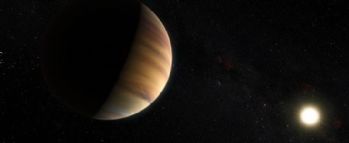
Astronomers using the HARPS planet-hunting machine at ESO's La Silla Observatory in Chile have made the first-ever direct detection of the spectrum of visible light reflected off an exoplanet. These observations also revealed new properties of this famous object, the first exoplanet ever discovered around a normal star: 51 Pegasi b. The result promises an exciting future for this technique, particularly with the advent of next generation instruments, such as ESPRESSO, on the VLT, and future telescopes, such as the E-ELT.
The exoplanet 51 Pegasi b lies some 50 light-years from Earth in the constellation of Pegasus. It was discovered in 1995 and will forever be remembered as the first confirmed exoplanet to be found orbiting an ordinary star like the Sun. It is also regarded as the archetypal hot Jupiter - a class of planets now known to be relatively commonplace, which are similar in size and mass to Jupiter, but orbit much closer to their parent stars.
Since that landmark discovery, more than 1900 exoplanets in 1200 planetary systems have been confirmed, but, in the year of the twentieth anniversary of its discovery, 51 Pegasi b returns to the ring once more to provide another advance in exoplanet studies.
The team that made this new detection was led by Jorge Martins from the Instituto de Astrofísica e Ciências do Espaço (IA) and the Universidade do Porto, Portugal, who is currently a PhD student at ESO in Chile. They used the HARPS instrument on the ESO 3.6-metre telescope at the La Silla Observatory in Chile.
Currently, the most widely used method to examine an exoplanet's atmosphere is to observe the host star's spectrum as it is filtered through the planet's atmosphere during transit - a technique known as transmission spectroscopy. An alternative approach is to observe the system when the star passes in front of the planet, which primarily provides information about the exoplanet's temperature.
The new technique does not depend on finding a planetary transit, and so can potentially be used to study many more exoplanets. It allows the planetary spectrum to be directly detected in visible light, which means that different characteristics of the planet that are inaccessible to other techniques can be inferred.
(...)